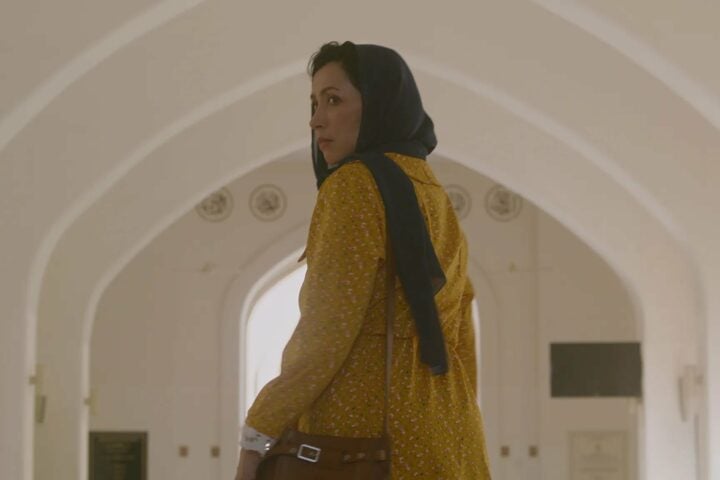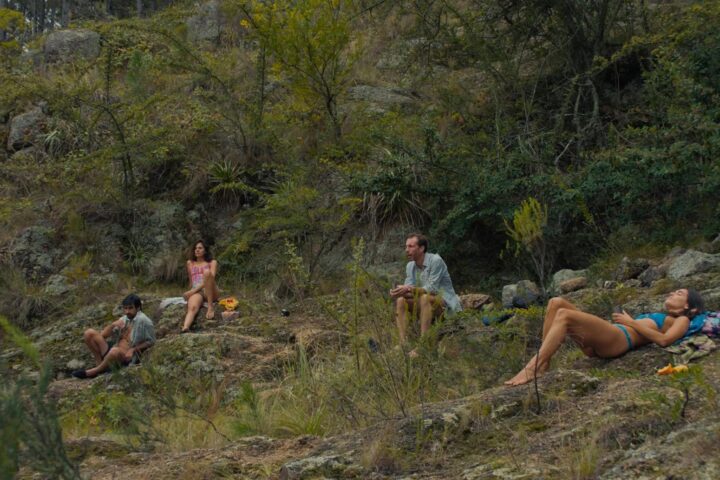While watching Aki Kaurismäki’s films, one may become aware of how peculiarly attentive the Finnish auteur is to room tones. And his latest, Fallen Leaves, is no exception: the vacuum-sealed deadness of a prefabricated one-room apartment; the cavernous bellow of a factory, enlivened by faraway clanks and moans; the slightly reverberant calm of a bar after the activity has died down; and the humming sine waves of a hospital room.
Such pleasantly varied tones constitute the sparse sonic world of Fallen Leaves, which takes place in an impoverished, industrial corner of Helsinki that will be familiar to viewers of Kaurismäki’s stubbornly proletariat cinema. They provide shades to the film’s overarching loneliness and drudgery, and it seems there are only two alternatives to this droning stillness: music, which wafts in the air from karaoke bar stages and record players, and radio news broadcasts, which unfailingly transmit tragic missives from the war in Ukraine. In other words, they constitute relief from and reminders of the doomed world that Fallen Leaves depicts.
As ever, such a grim premise doesn’t play out so grimly in Kaurismäki’s hands. Indeed, the maestro of deadpan evinces a total command of his singular filmic language, which is calibrated with precision to wring humor and pathos from otherwise despondent scenarios. Fallen Leaves recalls early-career efforts like 1986’s Shadows in Paradise, 1988’s Ariel, and 1990’s The Match Factory Girl—informally characterized as his Proletariat Trilogy—in its focus on solitary workers bungling their way through various menial labor gigs, leveraging their meager spare time and cash to seek some form of meaningful connection at local watering holes. And as in those films, Kaurismäki scripts are composed of laconic exchanges that call attention to the inadequacy of words to communicate deep chasms of heartache and loss.
The film’s gratifyingly classical structure is built around crosscutting between two narrative strands. In one, the handsome but defeatist construction worker Holappa (Jussi Vatanen) tries to hang on to a job sandblasting large metalware while routinely sneaking swigs of vodka in the corners of factory floors. In the other, the headstrong Ansa (Alma Pöysti) contends with bureaucratic nonsense and bad luck at a string of low-paying, dead-end jobs.
Holappa and Ansa’s paths first cross in an early bar scene that crystallizes Kaurismäki’s spare but exacting aesthetic. As an older patron croons a maudlin ballad in the background, Holappa’s drinking buddy, Huotari (Janne Hyytiäinen), hits on one of Ansa’s friends, Liisa (Nuusa Koivu), in one of the bar’s booths. Sitting next to Liisa is Ansa, who catches Holappa’s eye, which prompts him to shuffle off to a shadowy corner to smoke. The scene plays out with a balanced attention to each bit of business—the surprisingly proficient singer, the halting courtship, and the silent back and forth of averted gazes between Ansa and Holappa—all while achieving a gentle harmony of wry humor, piquant melancholy, and fine-tuned social observation.
Such sequences contain only basic narrative information, yet they conjure a world of feeling through understated mise-en-scène and Kaurismäki’s instinct for editing tempo. His compositions are never cluttered, as simple chiaroscuro lighting draws the eye toward minute shifts in staging and clever bits of art direction, like the clusters of beer glasses or the faded posters that place Fallen Leaves in an anachronistic limbo. And he pares the expressions of his cast down to the bare minimum, enabling any sudden or unexpected movement—like a climactic wink delivered by Pöysti—to arrive like a bolt of lightning. The filmmaker’s luminaries are no secret (who else would put not one but two overt Bresson references into the same shot?), and yet few living filmmakers create images with such instantly identifying features.
It’s in this hyper-selective directorial context that the sounds of Holappa and Ansa’s world become of paramount importance. When the two finally share a quiet evening at the latter’s inherited apartment on the outskirts of town, the space’s hitherto numbing room tone takes on a serene sense of anticipation for the characters and the audience. Into this silence comes the stimulating fizz of a sparkling wine being poured before dinner, which for Ansa represents a symbolic shared pleasure and for Holappa a mere boost in blood alcohol concentration.
This inability to take sensory pleasure in his environment speaks to a larger blockage in Holappa’s psyche, one hinted at earlier in Fallen Leaves when Huotari notes the “circular reasoning” of his pal Huotari’s depressive thoughts, and it eventually curdles the evening’s potential. Shortly thereafter, Ansa attempts to lighten the mood with music from her tube radio and gets a rude torrent of dispatches on Mariupol massacres instead. When numb to the small pleasures of the everyday, existential calamities re-assert themselves.
Fallen Leaves isn’t a particularly complicated or dense film, but it’s deeply alert to the sensory pleasures of the world in a way few films are, which is ultimately what elevates it above the miserabilism latent in its scenario. In Kaurismäki’s hands, a scene of missed connection at a bus stop achieves its ringing poignancy not with dialogue or close-ups, but with the lovely play of light cast by a bus on the snoozing individual who missed getting on board.
And in an amusing tribute from one iconoclastic filmmaker to another, Kaurismäki sets Ansa and Holappa’s first date at a screening of Jim Jarmusch’s The Dead Don’t Die, a film that depicts a zombie invasion that brings a bored, anesthetized populace to the brink of extinction. That the budding lovers still leave the theater in a rare state of euphoria indicates Kaurismäki’s abiding belief that not all is lost if art and beauty can still surround us in unlikely places.
Since 2001, we've brought you uncompromising, candid takes on the world of film, music, television, video games, theater, and more. Independently owned and operated publications like Slant have been hit hard in recent years, but we’re committed to keeping our content free and accessible—meaning no paywalls or fees.
If you like what we do, please consider subscribing to our Patreon or making a donation.




